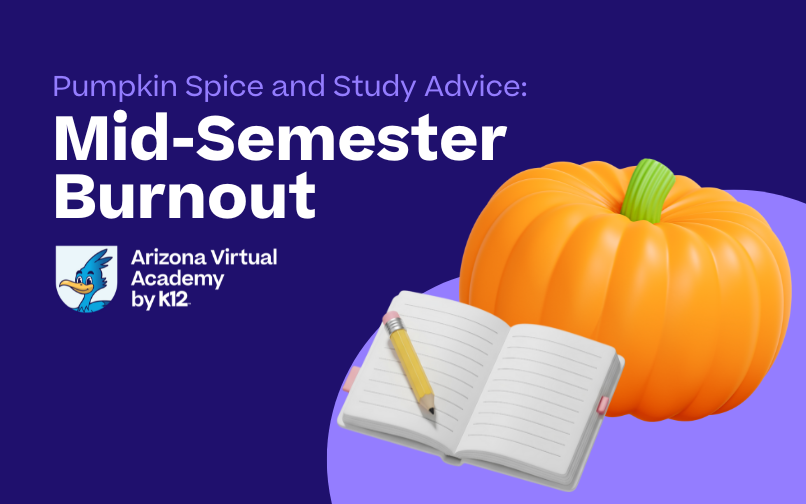Pumpkin Spice and Study Advice: Surviving Mid-Semester Burnout

When mid-semester burnout starts creeping in, it’s the perfect time for a quick reset strategy to chase away the mid-semester ‘scaries.’
First, give yourself a weekend to rest and recharge. Think of it as your own getaway from schoolwork where you can banish stress and recharge your energy.
After the reset, create a short “must-do” list with just three top priorities for the week, so you’re not overwhelmed by what feels like never-ending tasks. From there, trade in those all-night marathons for short, consistent study sessions. This small but powerful change will help keep your focus sharp.
Restore balance by scheduling both study time and downtime, ensuring you have room for pumpkin carving or a walk under the autumn leaves. By treating balance and rest as your top priority, you’ll keep burnout at bay.
Here are 6 study habits to help you further manage burnout and finish the year out strong:
1. Re-establish Structure
- Set a routine: Create a daily start and end time for classes, studying, and breaks. Consistency can help reduce decision fatigue.
- Designate a study space: Even if studying at home, choose one specific place (desk, table or quiet corner) to signal “school mode.” If you are tired of your current space, try mixing it up and pick a new area with a different view to re-energize your mind.
- Use time blocks: Try the Pomodoro technique. Study in 25 to 50-minute focused sessions with 5to 10-minute breaks. This can help prevent you from feeling overwhelmed.
2. Prioritize and Plan
- Identify urgent vs. important: Focus first on the assignments with deadlines, then long-term projects.
- Weekly check-in: Spend 15–20 minutes every Sunday reviewing deadlines and mapping out the coming week.
- Use simple tools: A planner, digital calendar, or to-do list app (like Todoist, Notion, or even sticky notes) to prevent you from feeling scattered. Colorful pens/markers can further help spark a renewed interest and creativity.
3. Manage Burnout Directly
- Acknowledge it: Burnout is a signal, not a failure. Normalize rest and self-care as part of your productivity.
- Incorporate active breaks: Take walks, stretch or do a quick workout to reset low energy.
- Mini rewards: After finishing a task, treat yourself with something enjoyable (music, a snack or short video).
4. Improve Focus and Efficiency
- Single tasking over multitasking: Work on one subject or assignment at a time.
- Limit digital distractions: Silence notifications, use website blockers or keep your phone out of reach during study sessions.
- Summarize learning: After each class, write a short recap in your own words to reinforce memory.
5. Stay Connected
- Form small study groups: Even virtually, connecting with fellow peers helps reduce isolation.
- Ask for support: Reach out to your teachers, advisors or classmates if you are worried about falling behind— the mid-semester timeframe means you have time to ensure you’re on track.
- Check in with accountability partners: Share goals with a friend or family member to help stay motivated.
6. Care for Mental and Physical Health
- Sleep first: Prioritize 7–9 hours of sleep. If you get less sleep than this, exhaustion can amplify burnout.
- Nutrition & hydration: Avoid energy crashes by eating balanced meals and drinking plenty of water.
- Mindfulness practices: Try journaling, deep breathing or short meditations to reduce stress. You can even find a good app that can walk you through these practices.


